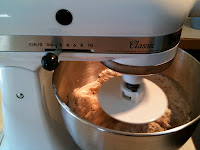I think I'll probably play around with this some more, but the resulting loaf was good enough to serve to friends (and get several compliments). If you want to try this yourself, be sure to grease your loaf pan well so that the cheese doesn't cement the loaf into the pan. <wink, wink>
Cheesy Corn Bread
2 Tbsp. canola oil
2 Tbsp. honey
1 1/4 c. water
2 eggs, beaten
3 c. white bread flour
1/2 c. corn flour
1/2 c. cornmeal
1/2 Tbsp. salt
1/2 Tbsp. yeast
1/2 oz. sharp cheddar cheese, grated
Beat the eggs and combine with the remaining wet ingredients in the bottom of a mixer bowl. Combine the dry ingredients separately and add to the the mixer bowl. Mix on low until all of the dry ingredients have been incorporated and the dough balls up on the dough hook. The dough will be very soft. Knead gently on a lightly floured surface until the dough is smooth, then let it rest for 10 minutes. Knead gently a second time to build up the strength of the dough, then let it rise for 45 minutes, or until about doubled in size. Shape the dough into a loaf, place it into a greased loaf pan, and allow it to rise a second time. Spray the loaf with water and sprinkle the grated cheese over the top before baking. Bake at 375 °F for 35 minutes, then turn the oven off and let the bread remain inside for 10 minutes more. Slice after cooling.
I find myself wondering if some actual corn kernels would be good in this? Or perhaps green chilies? Any opinions out there?














































